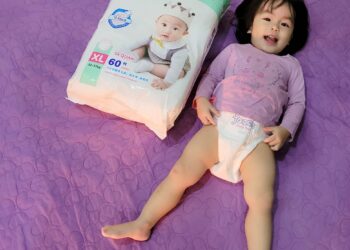For first-time parents, using diapers for their baby often raises many concerns. How to prevent diaper rash and skin irritation in newborns? What is the correct way to use diapers for newborns? Refer to this article right away, moms!
How to use Diapers for Newborns Correctly
Prepare adequately

To make changing diapers for newborns quick and efficient, before you begin, mothers, please prepare these items:
A safe and clean place
At home, mothers can use a dedicated changing table or a long bed/chair to change the baby’s diaper. Place a towel/cloth on the changing table or bed to protect the baby’s skin.
If using a dedicated changing table, mothers should use a safety strap for the baby. But if on a bed/long chair, be extremely attentive to the baby. By the time they reach 4 months old, babies start rolling. Mothers need to keep a close eye on them!
Diapers
Mothers can use cloth diapers or disposable diapers, the right size for the baby. You can choose adhesive diapers or pants diapers. Additionally, mothers should select reputable diaper brands in the market. Currently, many mothers opt for Korean diapers. Not only are these diapers improved, but they can also significantly reduce diaper rash and skin irritation for the baby!
Wiping cloth for the baby
Many parents use regular wiping cloths to clean their baby. However, a newborn’s skin is very sensitive. Therefore, mothers should choose soft milk cloths or wipes from reputable brands. Specifically, opt for wipes with antibacterial properties to prevent diaper rash and chafing, ensuring safety for the baby’s skin, moms!
Extra clothes, “emergency” items
If the baby is uncooperative during diaper changes and ends up wetting the clothes they’re wearing, mothers, remember to prepare an extra set of clothes for the baby.
Diaper Changing Steps
Step 1: Lay the baby on their back. Remove pants and clothing if they hinder the diaper changing process.
Step 2: Undo the soiled diaper. For disposable diapers, peel off each adhesive tab and fold it back.
Step 3: Gently lift the baby’s legs and pull out the soiled diaper, placing it aside.
Step 4: Wipe the baby’s bottom with a wet cloth or baby wipe. Clean all the folds in the baby’s thighs and buttocks. If it’s a girl, wipe from front to back to prevent infections.
Step 5: If the baby’s skin is irritated and needs cream, apply it. Otherwise, skip this step.
Step 6: Wait a few seconds for the baby’s skin to dry and air out before putting on a new diaper.
Step 7: Take a new diaper and place it under the baby. Pull the front half of the diaper up to the baby’s belly. For boys, make sure their penis is facing downwards to prevent urine from getting on the top of the diaper.
For newborns, avoid covering the umbilical cord stump until it dries and falls off. Ensure the diaper size fits the baby comfortably without being too tight. Then, fasten the adhesive tabs snugly but avoid them sticking to the baby’s skin.
Step 8: Dress the baby and place them in a crib or a safe place while you tidy up.
Step 9: Fold the soiled diaper and dispose of it in the trash. Remember to wash your hands thoroughly.
8 Important Tips for Preventing Diaper Rash While Changing Diapers
- Check your child’s diaper frequently (every 2 hours) and change it promptly. Change diapers approximately every 4 hours.
- Clean the baby thoroughly, especially the genital area, skin folds in the thighs or buttocks – these areas are prone to diaper rash.
- Avoid using wipes/soaps/products containing irritants for the baby: artificial fragrances, surfactants, parabens, etc.
- Avoid excessive rubbing on the baby’s skin as it can cause irritation and scratches.
- Do not use overly tight diapers on the baby. Tight diapers can cause discomfort, hinder airflow and create a suffocating sensation, especially when the baby has urinated or had a bowel movement in the diaper. Urine and feces create a moist environment that can lead to diaper rash.
- Always carry spare diapers when going out with the baby. Newborns can wet between 8 to 10 diapers a day.
- If the diaper leaks backward, consider two things: it may be due to insufficient absorption of the diaper, or the diaper size is smaller than the baby’s weight. In both cases, consider changing the diaper size or trying a different brand.
- Choose diapers with a higher SAP content to optimize absorption capabilities.






